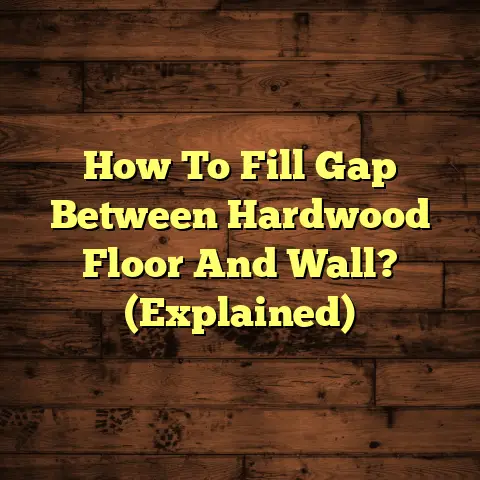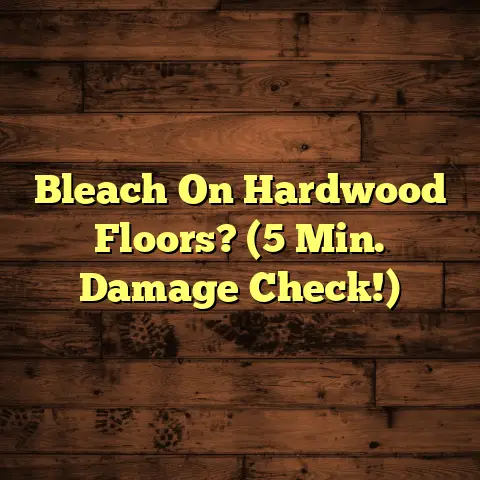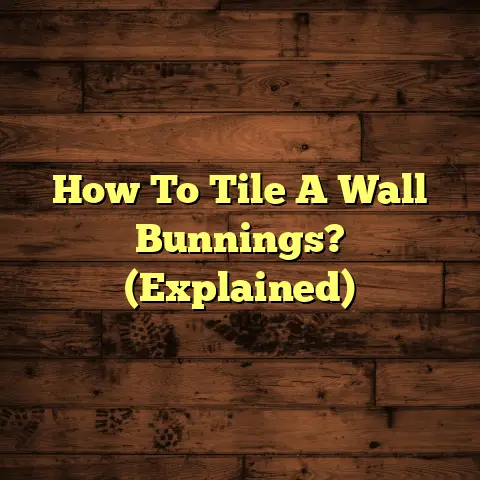Prep Basement Floor For Vinyl? (7 Install Mistakes!)
I’m pumped to share some insights about transforming your basement with vinyl flooring.
It’s a total game-changer!
Vinyl’s affordability, durability, and amazing looks have made it super popular.
Imagine turning that dingy, unused space into a killer home theater, a playroom for the kids, or even a home gym!
But here’s the thing: while vinyl flooring is pretty user-friendly, the KEY to a flawless install is all about the prep work.
Trust me, I’ve seen it all in my years as a flooring contractor.
Skipping steps or cutting corners during prep can lead to some serious headaches down the road.
We’re talking bubbling, cracking, and peeling – nobody wants that!
So, let’s dive into the seven most common mistakes I see homeowners make when prepping their basement floor for vinyl.
I’m gonna arm you with the knowledge to avoid these pitfalls and ensure your new floor looks amazing for years to come!
Understanding the Importance of Proper Preparation
Okay, so why is this prep stuff so crucial?
Think of it like this: your basement floor is the foundation for everything else.
If it’s not solid, level, and clean, your vinyl flooring is gonna suffer, plain and simple.
Basements are unique environments, and they throw some curveballs our way.
Moisture is a big one.
Basements are often below ground level, making them prone to dampness and even flooding.
Uneven surfaces are another common issue.
Concrete slabs can settle over time, creating dips and high spots that’ll show through your vinyl if you don’t address them.
Temperature fluctuations can also play a role.
Basements can get chilly in the winter and humid in the summer, and these changes can affect how your vinyl flooring expands and contracts.
Ignoring these challenges can lead to some serious problems down the line.
Moisture can cause mold and mildew growth under your flooring, which is a health hazard.
Uneven surfaces can make your floor feel unstable and look unprofessional.
And temperature fluctuations can cause your vinyl to buckle or warp.
Bottom line: proper prep is essential for a successful and long-lasting vinyl floor installation.
It protects your investment and ensures your basement transformation is a success!
Mistake #1: Ignoring Moisture Testing
Alright, let’s talk about moisture.
This is, without a doubt, the most common mistake I see homeowners make.
You might think your basement floor feels dry, but appearances can be deceiving.
Concrete is porous, which means it can absorb moisture from the ground.
And if that moisture gets trapped under your vinyl flooring, it can cause all sorts of problems.
That’s why moisture testing is absolutely essential.
So, how do you test for moisture?
There are a couple of common methods:
Calcium Chloride Test:
This is considered the “gold standard” for moisture testing.
You basically place a small dish of calcium chloride on the floor, seal it with a dome, and let it sit for a specified period (usually 72 hours).
Then, you weigh the dish again to see how much moisture the calcium chloride absorbed.
The results are expressed in pounds of moisture per 1,000 square feet per 24 hours.
* Moisture Meters:These are electronic devices that measure the moisture content of the concrete.
They’re quick and easy to use, but they’re not always as accurate as the calcium chloride test.
There are two main types: pin meters, which penetrate the surface, and pinless meters, which use radio waves to measure moisture.
So, what are acceptable moisture levels for vinyl flooring installation?
It depends on the type of vinyl you’re using and the manufacturer’s recommendations.
But generally speaking, you want to see moisture levels below 3 pounds per 1,000 square feet per 24 hours using the calcium chloride test.
With moisture meters, you’re typically looking for readings below 4-5%.
Ignoring moisture testing can have serious consequences.
Excessive moisture can cause the adhesive to fail, leading to bubbling and peeling.
It can also promote mold and mildew growth, which can damage your flooring and create a health hazard.
I’ve seen basements where the vinyl flooring literally lifted off the floor due to moisture!
Don’t skip this step.
It’s a small investment that can save you a ton of money and headaches in the long run.
Mistake #2: Not Cleaning the Surface Thoroughly
Okay, let’s talk about cleanliness.
I know it sounds obvious, but you’d be surprised how many homeowners skip this step or don’t do it properly.
Think about it: your vinyl flooring is going to be glued directly to the basement floor.
If that floor is covered in dust, debris, or old adhesive, the adhesive won’t bond properly, and your flooring will start to fail.
Common contaminants include:
Dust and Dirt: This is the most obvious one.
Even if your basement looks clean, there’s likely a layer of dust and dirt on the floor.
* Debris: This can include anything from small pebbles to pieces of drywall or wood.
* Old Adhesive: If there was previous flooring in your basement, there’s likely some old adhesive residue on the floor.
* Paint or Sealant: If the floor was previously painted or sealed, that coating needs to be removed.
* Grease or Oil: If your basement is used as a workshop, there may be grease or oil stains on the floor.
So, how do you effectively clean the basement floor before installation?
Here’s a step-by-step guide:
Sweep or Vacuum: Start by removing any loose debris with a broom or vacuum.
A shop vac is ideal for this.
2.
Scrape: Use a floor scraper to remove any stubborn debris, old adhesive, or paint.You can rent these at most home improvement stores.
3.
Wash: Use a mild detergent and water to wash the floor thoroughly.Be sure to rinse well to remove any soap residue.
4.
Degrease (if necessary): If there are grease or oil stains, use a degreasing cleaner to remove them.Follow the manufacturer’s instructions carefully.
5.
Rinse Again: Rinse the floor thoroughly with clean water.
6.
Dry: Allow the floor to dry completely before proceeding with the next step.This may take several hours or even overnight.
I recommend using a concrete cleaner and degreaser.
A clean floor is a happy floor!
Mistake #3: Overlooking Floor Leveling
Alright, let’s talk about levelness.
Imagine trying to build a house on a foundation that’s not level.
It’s a recipe for disaster, right?
The same goes for your vinyl flooring.
If your basement floor isn’t level, your vinyl flooring will reflect those imperfections.
You’ll end up with an uneven, unstable floor that looks unprofessional and feels uncomfortable to walk on.
So, how do you assess floor levelness?
There are a couple of ways:
Long Level: Use a long level (at least 6 feet) to check for dips and high spots.
Place the level on the floor and look for gaps between the level and the floor.
* Straight Edge: Use a long, straight edge (like a piece of lumber) to check for unevenness.Place the straight edge on the floor and look for gaps.
* Self-Leveling Laser: This is the most accurate method.A self-leveling laser will project a level line onto the floor, making it easy to identify dips and high spots.
So, what do you do if you find dips or high spots?
There are a couple of techniques for leveling the floor:
Self-Leveling Compound: This is a pourable liquid that spreads out and levels itself.
It’s ideal for correcting minor imperfections and creating a smooth, level surface.
* Floor Underlayment: This is a thin layer of material that’s installed over the existing floor to create a smoother, more level surface.It’s a good option for correcting minor imperfections and providing additional cushioning.
I usually recommend self-leveling compound for basements because it creates a very smooth, level surface that’s ideal for vinyl flooring.
However, it can be a bit more expensive and time-consuming than using floor underlayment.
Don’t skip this step!
A level floor is essential for a professional- looking and long-lasting vinyl flooring installation.
Mistake #4: Skipping the Underlayment
We talked about underlayment briefly when we were discussing leveling, but it’s such an important topic that it deserves its own section.
Underlayment is a thin layer of material that’s installed between the basement floor and the vinyl flooring.
It serves several important purposes:
- Sound Insulation: Underlayment can help to dampen sound, making your basement quieter and more comfortable.
- Moisture Barrier: Some types of underlayment have a built-in moisture barrier that helps to protect your vinyl flooring from moisture damage.
- Cushioning: Underlayment can provide additional cushioning, making your floor more comfortable to walk on.
- Leveling: As we discussed earlier, underlayment can help to smooth out minor imperfections in the basement floor.
There are several different types of underlayment available:
Foam Underlayment: This is the most common type of underlayment.
It’s affordable, easy to install, and provides good sound insulation and cushioning.
* Cork Underlayment: This is a more expensive option, but it provides excellent sound insulation and cushioning.It’s also naturally resistant to mold and mildew.
* Rubber Underlayment: This is a durable and long-lasting option that provides good sound insulation and cushioning.It’s also resistant to moisture and mold.
So, how do you select the right underlayment for vinyl flooring in a basement setting?
Here are a few factors to consider:
- Moisture: If your basement is prone to moisture, choose an underlayment with a built-in moisture barrier.
- Sound Insulation: If you want to reduce noise in your basement, choose an underlayment with good sound insulation properties.
- Cushioning: If you want a more comfortable floor, choose an underlayment with good cushioning properties.
- Budget: Underlayment prices can vary widely, so choose an option that fits your budget.
I usually recommend foam underlayment for basements because it’s affordable, easy to install, and provides good sound insulation and cushioning.
But if you’re concerned about moisture, I’d recommend choosing an underlayment with a built-in moisture barrier.
Don’t skip the underlayment!
It’s a small investment that can make a big difference in the comfort, durability, and longevity of your vinyl flooring.
Mistake #5: Failing to Acclimate the Vinyl
Okay, let’s talk about acclimation.
This is a step that many homeowners overlook, but it’s crucial for ensuring a successful vinyl flooring installation.
Acclimation is the process of allowing the vinyl flooring to adjust to the temperature and humidity of the room before installation.
Why is this so important?
Vinyl flooring expands and contracts with changes in temperature and humidity.
If you install vinyl flooring that hasn’t been acclimated, it may buckle or warp after it’s installed.
The recommended acclimation period is typically 48-72 hours.
However, the actual acclimation period may vary depending on the type of vinyl flooring you’re using and the environmental conditions.
Here are a few tips on how to properly acclimate the vinyl planks or tiles before installation:
- Bring the vinyl flooring into the basement: At least 48-72 hours before you plan to install it.
Spread out the boxes: Don’t stack the boxes on top of each other.
This will allow the vinyl flooring to acclimate more evenly.
* Maintain a consistent temperature: Keep the temperature in the basement consistent during the acclimation period.Avoid large temperature fluctuations.
* Check the manufacturer’s instructions: Be sure to follow the manufacturer’s instructions for acclimation.Some manufacturers may recommend a longer or shorter acclimation period.
I’ve seen homeowners install vinyl flooring straight from the store without acclimating it, only to have it buckle and warp a few weeks later.
Don’t make the same mistake!
Take the time to properly acclimate your vinyl flooring, and you’ll be rewarded with a beautiful and long-lasting floor.
Mistake #6: Incorrectly Measuring and Cutting Vinyl
Alright, let’s talk about measuring and cutting.
This is where precision is key.
Accurate measurements and cuts are essential for achieving a professional finish.
If you’re off by even a small amount, it can throw off the entire installation and leave you with gaps or overlaps.
So, how do you measure the basement floor and cut vinyl pieces correctly?
Here’s a detailed guide:
Measure the Room: Use a tape measure to measure the length and width of the basement floor.
Be sure to measure the room in multiple places, as walls are not always perfectly straight.
2.
Create a Layout: Use graph paper to create a layout of the room.This will help you visualize how the vinyl flooring will be installed and determine how many pieces you’ll need.
3.
Account for Waste: Add extra material to your measurements to account for waste.A good rule of thumb is to add 10% to your total square footage.
4.
Transfer Measurements to Vinyl: Use a pencil and straight edge to transfer your measurements to the vinyl flooring.
5.
Cut the Vinyl: Use a utility knife or vinyl cutter to cut the vinyl flooring.Be sure to use a sharp blade for clean, accurate cuts.
6.
Test Fit: Before you install the vinyl flooring, test fit the pieces to make sure they fit properly.Make any necessary adjustments before applying adhesive.
Common mistakes in measuring and cutting include:
- Not measuring accurately: Double-check your measurements to make sure they’re accurate.
- Not accounting for waste: Add extra material to your measurements to account for waste.
- Using a dull blade: Use a sharp blade for clean, accurate cuts.
- Not cutting straight: Use a straight edge to guide your cuts.
- Not test fitting: Test fit the pieces before you install them to make sure they fit properly.
I’ve seen homeowners who were so eager to get their vinyl flooring installed that they rushed through the measuring and cutting process.
They ended up with gaps, overlaps, and a floor that looked unprofessional.
Take your time, be precise, and you’ll be rewarded with a beautiful and seamless vinyl flooring installation.
Mistake #7: Neglecting Expansion Gaps
Alright, last but not least, let’s talk about expansion gaps.
This is another step that many homeowners overlook, but it’s essential for preventing buckling and warping.
Expansion gaps are small spaces that are left around the perimeter of the flooring.
They allow the vinyl flooring to expand and contract with changes in temperature and humidity without putting pressure on the surrounding walls.
Why is this so important?
As we discussed earlier, vinyl flooring expands and contracts with changes in temperature and humidity.
But generally speaking, you want to leave a gap of about 1/4 inch around the perimeter of the flooring.
Here are a few guidelines on how to determine the appropriate size for expansion gaps:
- Room Size: The larger the room, the larger the expansion gaps should be.
- Environmental Conditions: If you live in an area with large temperature and humidity fluctuations, you’ll need to leave larger expansion gaps.
-
Manufacturer’s Instructions: Be sure to follow the manufacturer’s instructions for expansion gaps.
Some manufacturers may recommend a different gap size.
I’ve seen homeowners who installed their vinyl flooring without leaving expansion gaps, only to have it buckle and warp a few months later.
Don’t make the same mistake!
Leave expansion gaps around the perimeter of your flooring, and you’ll prevent buckling and warping and ensure a long-lasting vinyl flooring installation.
Conclusion
Okay, that was a lot of information!
Let’s recap the seven common installation mistakes we discussed:
- Ignoring Moisture Testing
- Not Cleaning the Surface Thoroughly
- Overlooking Floor Leveling
- Skipping the Underlayment
- Failing to Acclimate the Vinyl
- Incorrectly Measuring and Cutting Vinyl
- Neglecting Expansion Gaps
Avoiding these mistakes is essential for a successful vinyl flooring installation in your basement.
Remember, proper preparation is the key to a beautiful, long-lasting floor.
Take the time to do it right, and you’ll be rewarded with a basement that enhances the value and enjoyment of your home.
Don’t rush the process.
Take your time, follow these tips, and you’ll be able to transform your basement into a space you’ll love for years to come!
Now go get that basement looking amazing!





